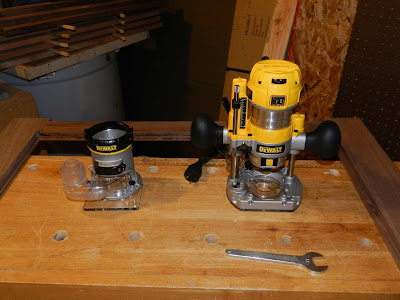Today I was asked a question on twitter. Kenny Comeaux asked me to recommend a trim router. Apparently, as I have as many routers as I do fingers (no, I’ve not cut any off), I’ve picked up a bit of a reputation as a router expect. Kenny’s timing was perfect, as tonight was the first time I used my new DeWalt DWP611PK trim router kit. I’m happy to share my opinion, and I figured here was the best place to do so.
What’s so cool about the DWP611PK?The DWP611PK is a revolutionary trim router kit unlike any other trim router (sister company Porter-Cable has a DWP611PK clone). The revolutionary feature of the DeWalt is that it’s a standard fixed base / plunge base combo, only with a trim router motor. Also, and this would have been a deal killer for me had it gone the other choice, there are reasonably priced dust shrouds for both the fixed and plunge bases.
Initial ImpressionsWhen I opened up the DWP611PK I was impressed. Though I’ve handled the fixed base model at Home Depot & Lowes, opening my kit was the first time I’d held the plunge base. I found that both bases are solid and well balanced. The plunge base is smooth and easily operated. The clear baseplates on both bases combine with the two (2) built in LEDs to provide excellent visibility. I find this very important, as a lack of visibility due to the solid baseplates on some of my other routers is a big complaint of mine.
Adjustment MeansMy first, and arguably most versatile, router was a Porter-Cable 690 series. For as long as I’ve used it, I’ve never liked the adjustment mechanism of rotating the motor to bring it up or down. This requires unplugging it from the D-handle in order to rotate it, and when using the router against a reference surface, it has the potential of moving the bit relative to the reference surface if the motor and base are not perfectly round and centered.While the DWP611PK appears to have the same type of adjustment mechanism, DeWalt has vastly improved it. They have milled a vertical groove up the side of the threaded motor body and added a free-spinning threaded collar to the base. This results in a motor that does not spin, but only goes up and down. In use, you spin the threaded collar and the motor moves, guided by pins which ride in the vertical groove. I found this movement to be smooth and very easy to adjust.
The plunge base is very well done, in a rather standard choice. The release lever is spring loaded and easily reached by the left hand without removing the hand from the grip. There are five (5) turrets on the rotating stop and the stop bar on the body adjusts easily and has a sliding indicator bar for measuring depth movement. It is a standard plunge but funtional and well done nonetheless.
 |
| The DWP611PK Trim Router Kit |
 |
| The fixed base dust shroud. |
 |
| I didnt actually route the rabbet with the DWP611PK, I used the little DeWalt to route out the original rounded edges (penciled in in the photo) I left when I initially undercut the rabbet with my bigger OF1400. |
 | |
|
 |
| The 5 position (4 fixed, 1 adjustable) turret stop on the plunge base. |
 |
| Little router, large vacuum hose connection. |
0 comments:
Post a Comment